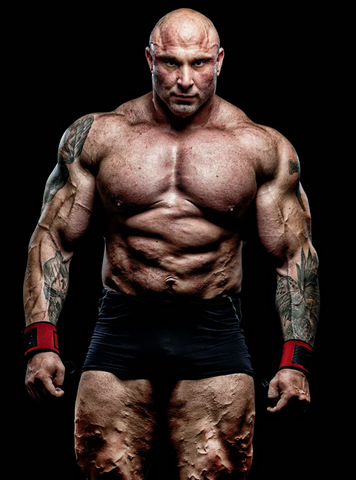Synthetic Microbial Process Produces Muscle Fibers That Are Stronger than Kevlar

Would you wear clothing or, say, shoelaces or a belt made of muscle fibers? Using a compartmentalized approach, scientists are mapping the human body and placing their results in a biomimetic humanoid. Currently, they are making fibers to simulate our muscular structure. These stronger-than-Kevlar fibers are very strong and resilient and are engineered and produced without harm coming to any animals. Nothing is taken from nature except raw, atomic materials.
Researchers at the McKelvey School of Engineering at Washington University in St. Louis, MO, are currently developing this synthetic chemistry technology, although I (Celeste) saw this technology introduced in a science committee meeting in 2006.
Researchers polymerize proteins inside of engineered microbes. Using this technology, the team engineered microbial production of the high molecular weight muscle protein, titin, which was then spun into fibers. Tests showed the fibers outperformed many synthetic and natural polymers. And you thought spider goats were strange back in the day!
Polymer Fused Proteins
“The beauty of the system is that it’s really a platform that can be applied anywhere,” said Cameron Sargent, a PhD student in the Division of Biological and Biomedical Sciences, Washington University in St. Louis. “We can take proteins from different natural contexts, then put them into this platform for polymerization and create larger, longer proteins for various material applications with a greater sustainability.” Sargent, and Christopher Bowen, PhD, who was at the Department of Energy, Environmental & Chemical Engineering, Washington University in St. Louis, and is now a senior scientist at Pfizer, are listed as the first authors of the team’s paper in Nature Communications, which is titled, “Microbial production of megadalton titin yields fibers with advantageous mechanical properties.” In this article they concluded, “These fibers have potential applications in areas from biomedicine to textiles, and the developed approach, coupled with the structure-function insights, promises to accelerate further innovation in microbial production of high-performance materials.”
Biomimicry at Work
Researchers find that biology, manifested in God's original creation, is a great source of inspiration for materials design and engineering, as nature can produce many high-performance, biodegradable materials efficiently, from renewable resources, and using only low-energy processes. In many cases, the researchers pointed out, “… these natural materials can outperform the best available petroleum-based alternatives.”
It’s not always possible to harvest such materials from their native sources as the United Nations (UN) has mandated "nothing from nature by 2030;” thus, the race is on to engineer synthetic alternatives. So, generating synthetic methods that mimic the natural biosynthetic processes at scale is highly desired and will become very profitable. “… engineered microbial production strategies are needed to facilitate the practical use and development of these high-performance, renewable materials,” the team continued.
Synthetic Muscle Proteins
The synthetic muscle protein produced in the lab of Fuzhong Zhang, PhD, a professor also at the Department of Energy, Environmental & Chemical Engineering, has now produced the synthetic muscle protein, titin, also known as connectin, which is one of the three major protein components of muscle tissue. Critical to the mechanical properties of titin is its large molecular size.
Titin is the largest protein in nature. Research continues to insert synthetic titin directly into muscles of soft robotics. This material will not come from animals, which is a UN taboo, but rather from microbes.
Engineered microbes can be used for scalable production of some small-molecule compounds. Direct microbial production of polymers with high mechanical performance is limited because they have ultra-high molecular weight with highly repetitive amino acid sequences. These highly repetitive proteins are, the scientists noted, “extremely difficult to produce in microbes due to genetic instability, low translation efficiency, and metabolic burden.”
To circumvent some of the issues that typically prevent bacteria from producing large proteins, the research team engineered bacteria to piece together smaller segments of the titin protein into polymers about 50 times the size of an average bacterial protein. They then used a wet-spinning process to convert the proteins into fibers that were around 10 microns in diameter, or one tenth the thickness of a human hair.
Working with collaborators, Young Shin Jun, PhD, professor in the Department of Energy, Environmental & Chemical Engineering, Washington University, and Sinan Keten, PhD, professor in the Department of Mechanical Engineering, Northwestern University, Evanston, IL, analyzed the structure of these fibers to identify the molecular mechanisms that enable their unique combination of exceptional toughness, strength, and damping capacity, and their ability to dissipate mechanical energy as heat. It is suggested that “these properties derive from unique inter-chain crystallization of folded immunoglobulin-like domains that resists interchain slippage while permitting intra-chain unfolding,” the researchers wrote.
Researchers at the McKelvey School of Engineering at Washington University in St. Louis have developed a synthetic chemistry approach to polymerize proteins inside of engineered microbes. This enabled the microbes to produce the high molecular weight muscle protein, titin, which was then spun into fibers. In the future, such material could be used for clothing, or even for protective gear. [Washington University in St. Louis]
These same scientists say that “by harnessing the biosynthetic power of microbes, this work has produced a novel high-performance material that recaptures not only the most desirable mechanical properties of natural muscle fibers (i.e., high damping capacity and rapid mechanical recovery) but also high strength and toughness, higher even than that of many man-made and natural high-performance fibers.”
Aside from its potential use in fancy clothes or protective armor, the material could have biomedical applications. This is because it is nearly identical to the proteins found in muscle tissue, this synthetic material is presumably biocompatible, and could therefore, be a great material for sutures, tissue engineering, and so on. The fiber’s highly desirable combination of mechanical properties, sustainable production process, and biodegradability make it an excellent candidate for environmentally friendly applications in a range of fields from biomedicine to commercial textiles, such as anti-ballistic materials, netting, sutures, and tissue engineering.
The production of synthetic muscle is cheap and scalable. The researchers do not intend to stop with synthetic muscles fiber, rather, piece by piece, engineer an entire synthetic humanoid with incredible strength. There is a very real danger that this synthetic material could potentially be injected into natural humans as well.
Blessings to you all-until the next time,
Celeste
____________________________________________________________

Celeste Solum is a broadcaster, author, former government, organic farmer and is trained in nursing and environmental medicine. Celeste chronicles the space and earth conditions that trigger the rise and fall of modern & ancient civilizations, calendars, and volatile economies. Cycles are converging, all pointing to a cataclysmic period between 2020 to 2050 in what many scientists believe is an Extinction Level Event.
Tracking goods and people will be a part of managing the population during this convergence.
-
Backstories on tracking
- Technologies
- Infrastructure
- Diseases, Testing, Vaccinations, and Sensors (including nCov and the new Phytophthora ~the plant-destroyer
-
Experiences
Website:
https://shepherdsheart.life/blogs/news/
GenSix, Keynote Speaker, True Legends, Ancient Cataclysms & Coming Catastrophes
https://celestialreport.com
https://www.facebook.com/ShepherdessCeleste
Books:
Electromagnetic Radiation Protection Solutions
Inspirational Homestead Recipes
Videos: Celestial Report, Special Broadcasts, Breaking News by Subscription